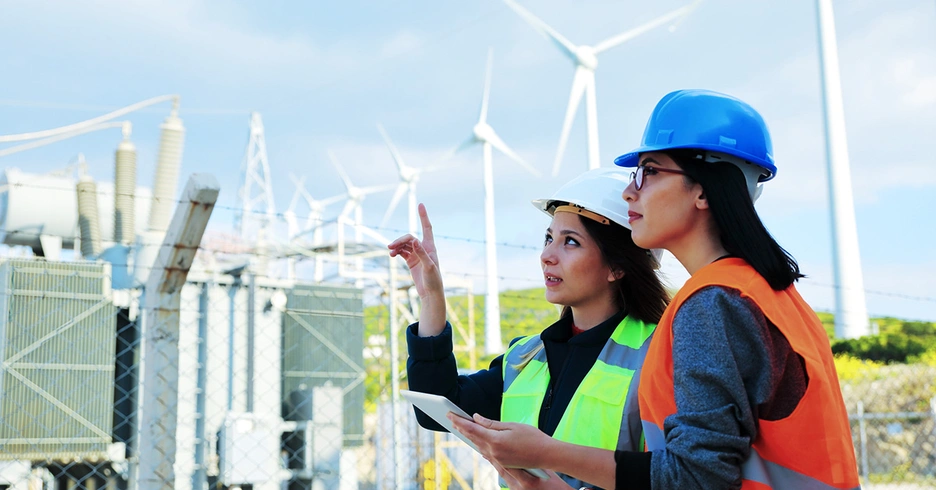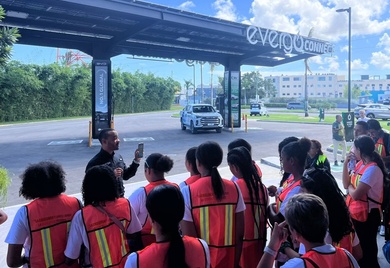Making Women Welcome: the Next Challenge for Renewable Energy Construction Projects

If the energy transition, and the renewable energy sector, are to create opportunities for women to enter male dominated fields, then opening low skill requirement and construction occupations must be a critical part of that strategy.
We previously wrote about the use of blended finance to close gender gaps in renewable energy, where the global share of female employment is at 32% (20% in the wind sector); on the other hand, construction remains almost exclusively male, and this makes a big difference in the fight for equal employment in Latin America and the Caribbean (LAC). Across the region, female participation in the construction sector is estimated between 1% and 6%.
Whether tracked by supply chain segment, certification level, or education level required, low- and semi-skilled workers represent most employment in renewable energy sectors: over 60% in both the solar and wind industries. Renewable energy project sponsors have a critical role to play the training of unskilled workers to create new labor pools, since evidence increasingly shows that employer-led or -focused training programs in high growth industries combined with on-the-job training leads to significant impacts in employment and earnings for target populations, relative to more diffuse public sector led training and credential programs.
If we want the benefits of the energy transition extended to women, then private sector-led workforce development – focused on female employment in construction – is critical.

That’s the good news. Then there are the challenges for a multilateral or other project finance lenders when it comes to influencing construction labor outcomes, which are several:
• Traditionally, construction markets in project financing deals are often overlooked, since the focus is on the long-term economic benefits that the project, once operating, will bring. Conversely, construction is often seen as transitory, and employment may be difficult to track or standardize across contractors.
• Lenders traditionally have little visibility regarding the construction labor force. Our clients are project sponsors, not the contractors responsible for delivering the fully constructed and operating project, and certainly not their subcontractors where all the actual labor is hired.
• Incentives among all stakeholders for recruiting, training, and employing new labor are generally low. Sponsors and contractors have generally bid into the project using cost assumptions that do not include extraordinary investments in construction labor, and unsurprisingly are often uninterested in significant variances in cost or timing. In turn, lenders are interested in ensuring the project is built on time and on budget and require contractors to pay the borrowers penalties for any failure to do so.
IDB Invest has used blended finance as a tool to overcome some of these structural challenges, and the more entrenched challenge of occupational segregation in construction. Our early experiences in incentive design demonstrates that (a) female, unskilled, labor can be recruited and trained in semiskilled construction, (b) aggressive gender outcomes in construction for individual projects are feasible.
Across projects in the region, we have seen female employment targets and outcomes between 10-20% of the construction workforce on a project, relative to a baseline that is actually as often as low as zero. They are performing core construction and technical functions. To get there, sponsors have to design and execute training programs, often for both men and women, necessarily benefiting more people than the project can employ but providing skills and certifications to all participants, broadening the impact of the program.
Beyond the estimates above, there is actually hardly any data available on female employment in construction in Latin America. The first wave of sponsors are really working without precedent, often with ambivalent contractors, and with cost estimates that are rarely based on historical experience. Incentive structures can accommodate uncertainties and help them develop confidence in their ability to design and deliver ambition female workforce programs. As they do so, it will become easier for them to make demands of contractors — the natural owners of construction focused workforce development — for gendered labor outcomes in future bids.
Incentives can also encourage critical strategies that support recruitment and retention of women. These include childcare, facilities (bathrooms and locker rooms can be dealbreakers), sexual harassment policies and workplace safety initiatives, as well as post project career guidance.
Actions to disseminate lessons learned among project and sector stakeholders may also help, especially with contractors and their industry associations, and other sponsors, but also local agencies and vocational training organizations with a vested interest in (female) workforce development and renewable energy.
For example, in the New Juazeiro Solar Bifacial PV Project in Brazil IDB Invest designed a tiered incentive structure with resources from the Climate Investment Funds (CIF) and the Canadian Climate Fund for the Private Sector in the Americas (C2F). This mechanism supported the sponsor not only to hit targets for female training and employment, but also to both document lessons learned and best practices as well as sharing them in workshops with the EPC contractor, industry peers, and vocational training institutions
Taken together, successful private sector-led workforce development programs in renewable energy projects can provide a powerful signalling effect to all stakeholders, including lenders, that women can be recruited, trained, and employed in renewable energy projects at scale and that workplace conditions can be improved to support recruitment and retention.
As the energy transition takes hold in LAC, sponsors and lenders should recognize the influence they can actually have on construction markets. There’s an opportunity for sponsors, lenders and donors to support a just transition, and also the growth of the supply chains necessary for that transition. IDB Invest has had early successes in developing incentives products with blended finance resources to support first-mover sponsors, but we are still learning, and we look forward to sharing new lessons with you soon.
LIKE WHAT YOU JUST READ?
Subscribe to our mailing list to stay informed on the latest IDB Invest news, blog posts, upcoming events, and to learn more about specific areas of interest.
Subscribe



